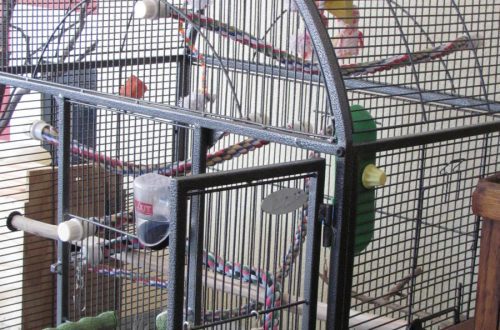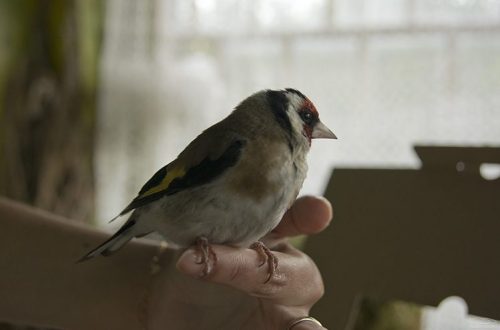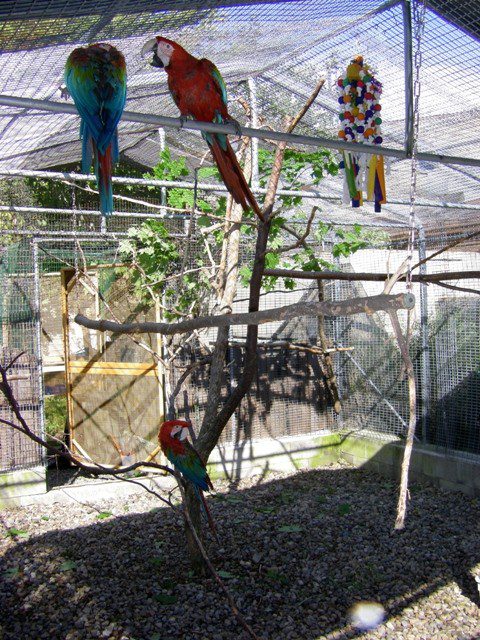
Aviary for parrots
Parrot aviaries are a great option for both owners and their birds. If you have one or a couple of feathered friends living in your house, there is no need to purchase an aviary, only if the area of uXNUMXbuXNUMXbthe room allows and you do not have the opportunity to provide the bird with regular walks outside the cage.
Budgerigar enclosures are very popular among the owners of these cheerful and energetic birds. Often birds spend the winter in an apartment, and for the summer and warm autumn they “move” to the balcony, where they lead a healthy lifestyle and feel quite comfortable.
Contents
Advantages of aviaries:
- thanks to flights, fresh air and sunlight (street enclosures), the body is strengthened, molting passes easier and faster;
- comfortable living conditions for parrots. Birds can fly and communicate with each other not only by shouting at a distance;
- convenience for the owner. Ease of maintenance of the enclosure and saving time, instead of several cages, you remove one, albeit a large one;
- all the birds get your attention at the same time, and none of them feel left out;
- ease of carrying out preventive vitamin courses and other manipulations, any deviation in the behavior of a bird contrasts with the rest of its relatives and is quickly detected;
- if you have a large species of parrot, then a competent aviary will help organize a normal regime for the bird (length of daylight hours) and protect the parrot from unwanted interference at certain points in the life of its owner without psychological damage to the pet.
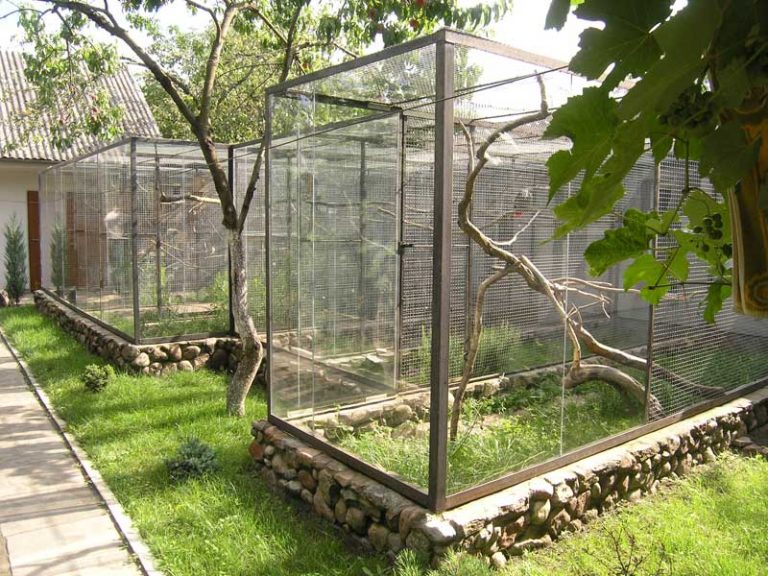
Cons of enclosures for parrots:
- enclosures “take over” a certain area of uXNUMXbuXNUMXbthe premises or plot;
- if one bird gets sick in the aviary, the rest of the birds are at risk. Timely isolation of a sick pet and preventive treatment for other parrots is mandatory;
- it is difficult to keep track of the “correct” nutrition of a particular bird (there is a risk of rejection of fruits and greens by one individual), although, in a flock, parrots quickly adopt each other’s habits;
- birds living in an aviary are difficult to tame;
- for breeding parrots, each pair still needs a separate cage with a nesting house. Of course, it is quite possible to breed birds in open-air cages, but in this case, it is much more difficult to provide a nesting pair with peace, good nutrition and control over the breeding and development of offspring.
Aviaries for parrots are street and designed for the room – indoor.
Outdoor (garden) enclosures differ primarily in their size, the roof and floor in such structures are built taking into account the climatic conditions of the country and for a certain type of parrot. Also in such enclosures there must be shelter in case of worsening weather conditions or danger from birds or rodents.
Photo of the outdoor enclosure:
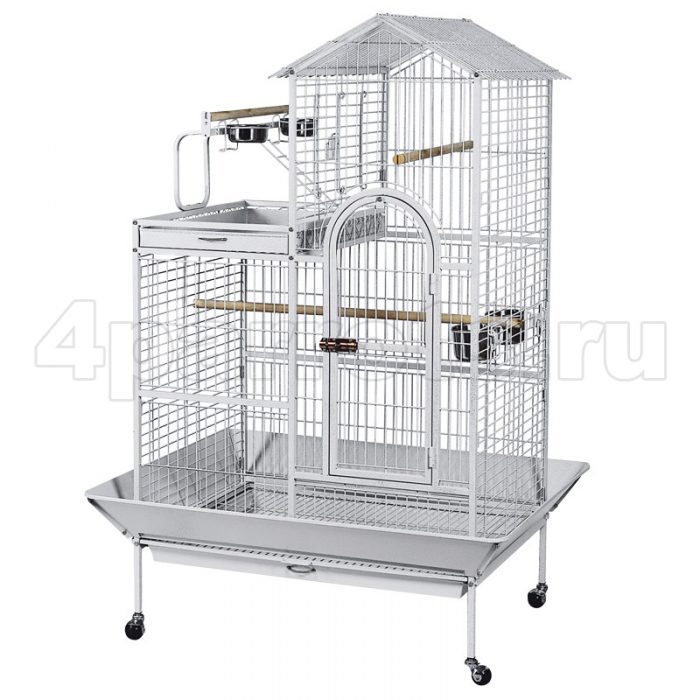
Aviaries can be both temporary and permanent. Temporary – these are most often seasonal enclosures, they move birds in the warm season, and with the onset of cold weather, parrots move to a warmer and more protected room.
Home aviaries are a large cage that is located in a room or on a balcony.
Today, different variations of such structures are presented in the markets and online stores, so buying an aviary for parrots is not at all difficult now. A much bigger problem is to fit the bird house into the interior of the room without wasting living space.
The price of such structures is quite high, so bird lovers most often try to make an aviary themselves, then the costs are significantly reduced, and the convenience of a home-made aviary cannot be compared with a standard store offer.
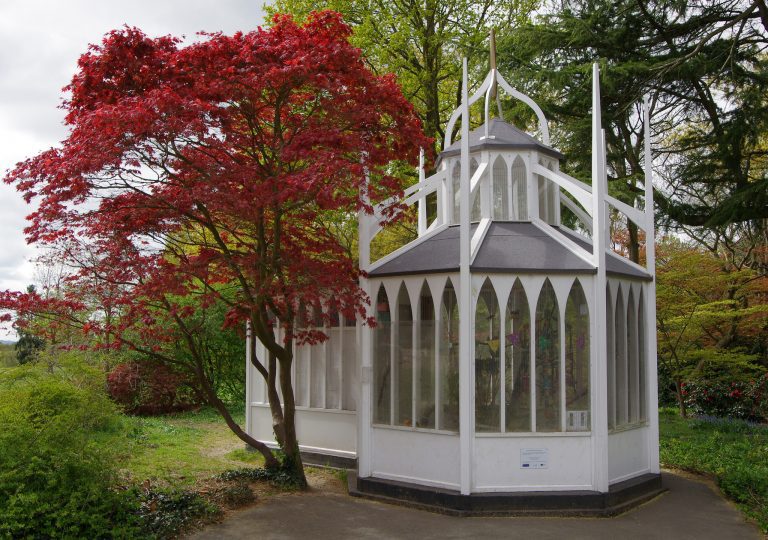
If you have a person who can build an aviary with his own hands, contact him. The main advantage of home-made aviaries is that you design a “bird house” not only based on the needs of parrots, but also taking into account the specifics of the place where the large cage will be located, you determine the number of doors and think in advance where you can hang nesting houses, your taste preferences and other inhabitants of the house.
In order to purchase a ready-made aviary for parrots, you just need to contact these online stores (links under the photo):
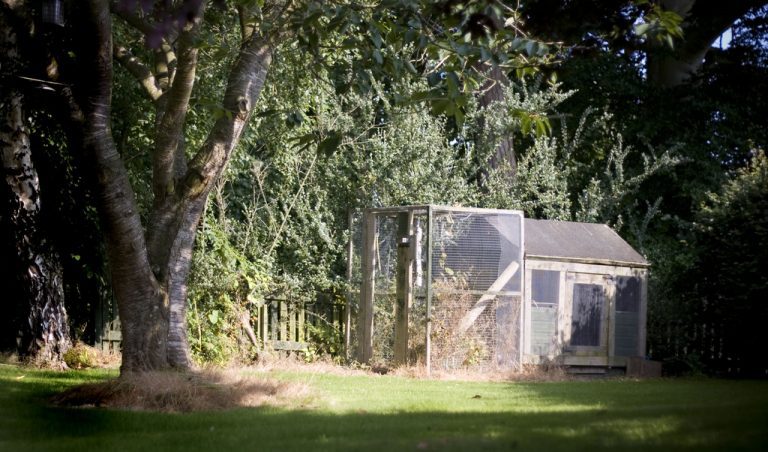
Outdoor enclosures for parrots
When building an outdoor aviary on your own, several important points should be taken into account.
If you want to build an all-season garden aviary for parrots, then you need to take the design much more seriously, since such an aviary should have a room with heating, lighting, and the foundation and walls of this design will be insulated. To understand what an all-season outdoor aviary should be like, pay attention to the principle by which poultry houses and pigeon houses are built.
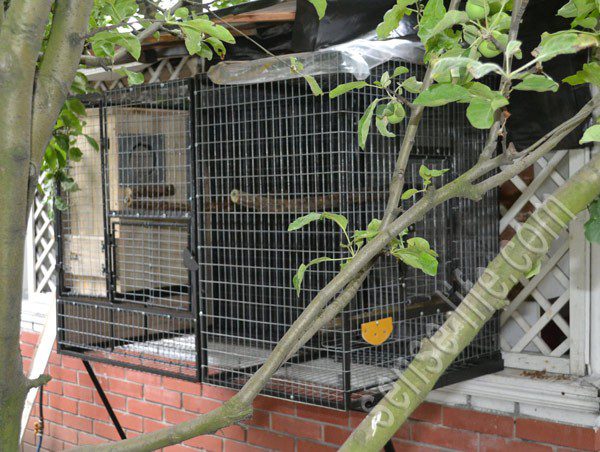
The rules for building a seasonal outdoor enclosure are slightly different.
To protect birds from rodents and small predators, you should build a foundation by deepening the trench by 30-40 cm or put the structure on legs at a safe distance from the ground. We fill the dug trench with large stones and rubble and fill everything with concrete to ground level, then we raise the brick wall to a height of 20 cm.
During the laying of bricks, every 1,5 meters we install a large bolt vertically above the last brick row by 10 mm. A mesh will be attached to it with a nut or welded to a frame from a metal corner. Holes are drilled in the lower part of the frame at the same distance as the bolts, the upper part of the frame and the sides must also be with holes for connection with adjacent structures. To facilitate assembly, the frame is made 1,5 by 2,5 m.
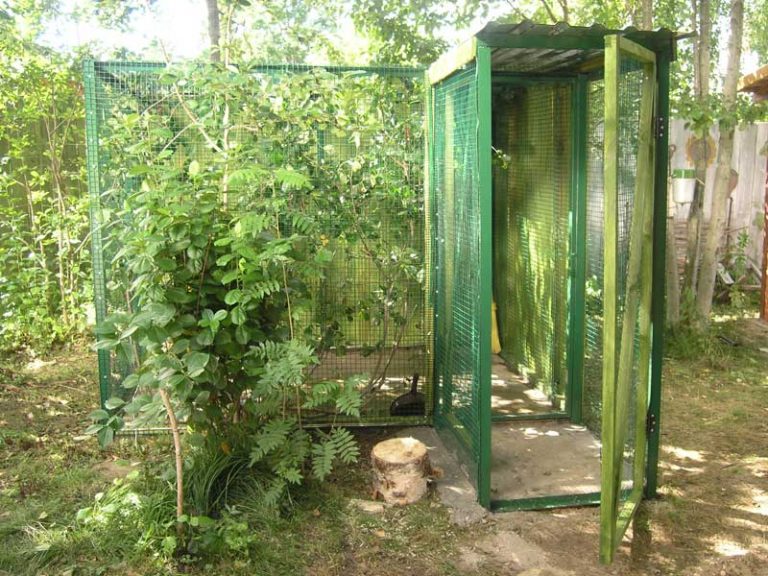
Outdoor enclosures are built up to 3 m wide, the length is chosen arbitrarily, as for the height, it should not exceed 2 meters, since higher enclosures complicate catching birds and caring for cage equipment as a whole (feeders, drinkers, perches, tree branches, nesting houses).
When installing the floor in an aviary, you should first stretch a fine mesh treated with anti-corrosion agents, and then you can pour concrete, fill in earth and sand, or lay boards. The metal mesh will serve as protection against small rodents that may try to enter the aviary for grain, eggs or small birds.
Recently, owners often use linoleum to cover the floor in aviaries – this greatly simplifies the maintenance of parrots and facilitates the maintenance of the floor surface, helping to quickly clean it of unwanted dirt and bird excrement.
It is advisable to make the floor in the aviaries at an angle to drain water – this will allow you to disinfect the surface and keep the home for birds in constant cleanliness.
It is desirable that the aviary has a roof or a partial canopy that protects the parrots from bad weather and the scorching rays of the sun. By placing the aviary so that a tree or shrub grows in its center, you will provide the birds with a natural shelter from the sun’s rays and the most natural habitat.
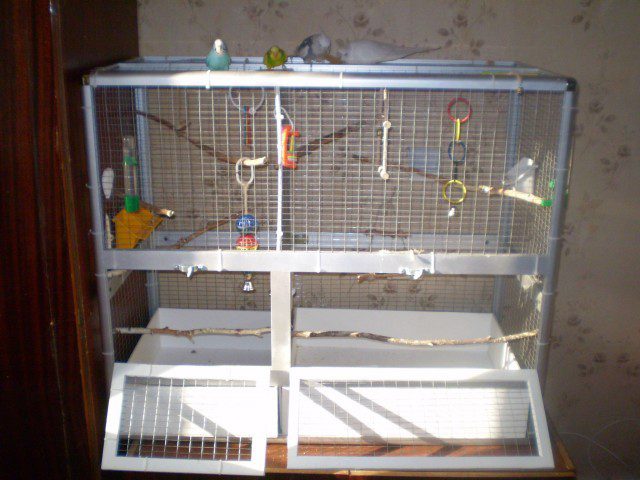
When buying the main mesh, get another one with larger cells of 40 x 40 or 50 x 50 mm, it will need to be pulled at a distance of 5-10 cm from the main one. The second layer is attached to the channel frame. This will help keep your birds safe from birds of prey and harm to your pets.
When building a cage for large parrots, owners often focus on ensuring that their pet cannot escape from the cage, but forget that the size of the cage should not allow small birds to “visit”. Wild birds can be carriers of diseases and parasites.
A double layer of a different-sized mesh will be the best option for the safe living of a pet on the street.
Parrots love to move not only along the large branches of trees provided to them, but also along the walls of the enclosure, it is this habit of birds that can lead them to injury or death if the enclosure is not covered with a control network.
If you have a choice of a place for a garden aviary, then try to place it so that the front part “looks” to the south or southeast. It is this position that will allow the birds to meet the dawn and “bathe” in the rays of the sun for as long as possible.
For a street enclosure, supports are needed; metal posts concreted into the ground can act as such. Metal corners are welded onto the posts, which will be the frame for the grid. When stretching the mesh, if additional cuts are required, overlap the mesh up to 20 cm by stitching the edges well.
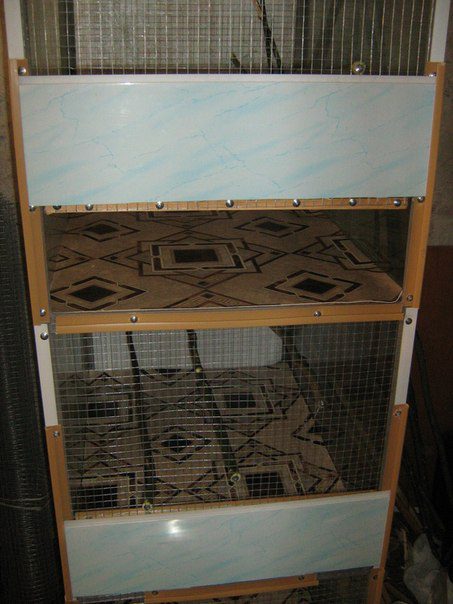
Carefully inspect the completed aviary for holes, crevices, or loose materials.
Garden enclosures are built with a vestibule, the presence of this extension is mandatory, since at the entrance to the enclosure it will not allow the parrot to fly out of the cage. In addition, you can store the necessary inventory there, which you may need when maintaining the enclosure.
Collapsible aviaries are very popular, they are often used by owners of medium and small parrots. For medium parrots, the mesh should be taken with a cell of 25 x 25 mm, the frame should be built from a square metal profile 15-17 mm. The dimensions of the enclosure are 200 x 150 x 70 cm. You should not forget to provide doors for changing food and water, in this case you can make a small door and a second one for comfortable cleaning and installation of branches and necessary accessories.
Plexiglas is also popular, a wall of it is installed on the north or windy side to protect the parrot from cool and strong air currents.
An example of an aviary for medium parrots:
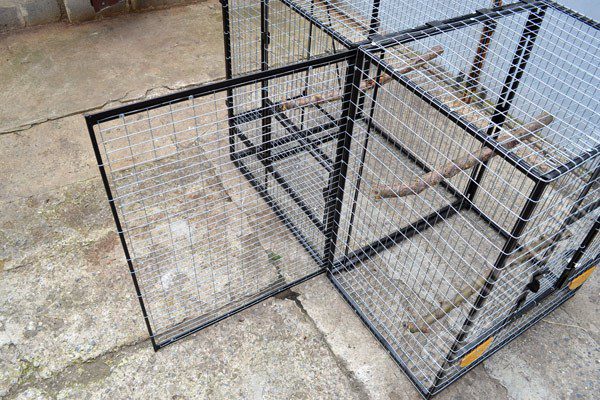
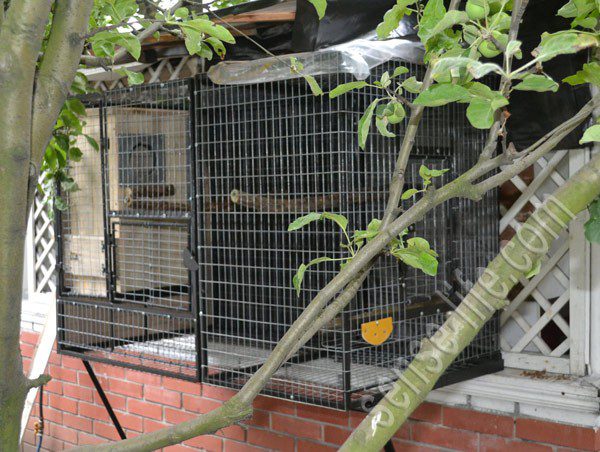
You can also make an aviary for parrots with your own hands from plastic pipes. You can read more details here.
Enclosures for medium and large parrots are most securely locked with padlocks. You will be sure that your pet, no matter how hard he tries to break free, will not be able to do it without your knowledge.
What should be the mesh for aviaries
The best option would be to buy a stainless steel mesh – it is the safest and most durable. Galvanized mesh is also durable, but the presence of zinc in it is dangerous for the health of birds. Despite this, due to its availability and practicality, owners often use it in makeshift enclosures.
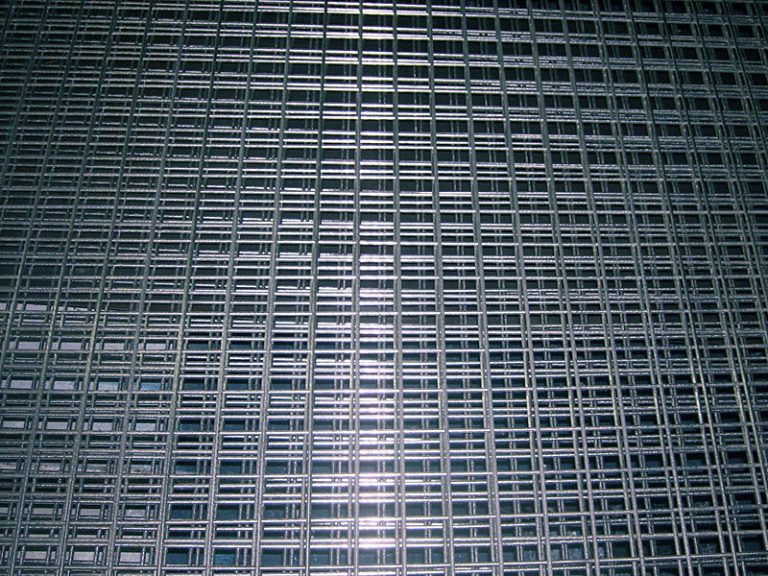
If you do not have the opportunity to purchase stainless steel, thoroughly rinse the galvanized mesh with warm water and a sponge and wipe it with vinegar. After rinsing, let the acetic acid evaporate and only then can you use the mesh.
Metal mesh covered with plastic or plastic mesh should not be considered suitable materials for parrot housing.
When buying a mesh, pay attention to the absence of rust and abrasions, which, in the future, can lead to it.
The thickness of the net for large parrots should be more than 5 mm, that is, such that the bird cannot bite it.
Do-it-yourself home (indoor) aviaries for parrots
Indoor aviaries for birds are fundamentally different from street ones. A preliminary drawing of the aviary on paper will help to avoid blunders and miscalculations, as well as determine the amount of materials and design of the cage.
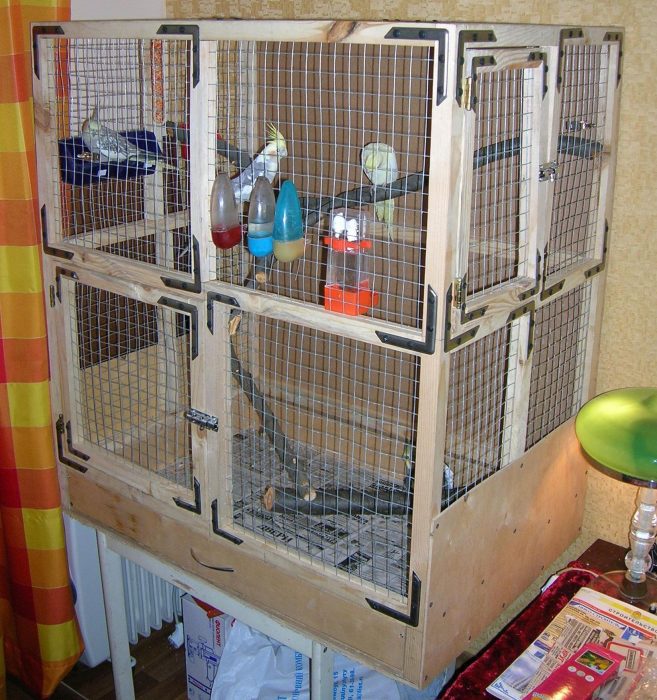
When building an aviary for budgerigars with your own hands, the size of the grid is very important. The optimal cell size is 15 x 15 mm, if the cells are rectangular, then a larger size is allowed.
For their construction, the following materials are used: washers, screws, bolts, latches for doors and curtains, welded mesh, metal corner or pipe, wood (hardwood only), wire, linoleum. For convenience, the owners try to make them collapsible.
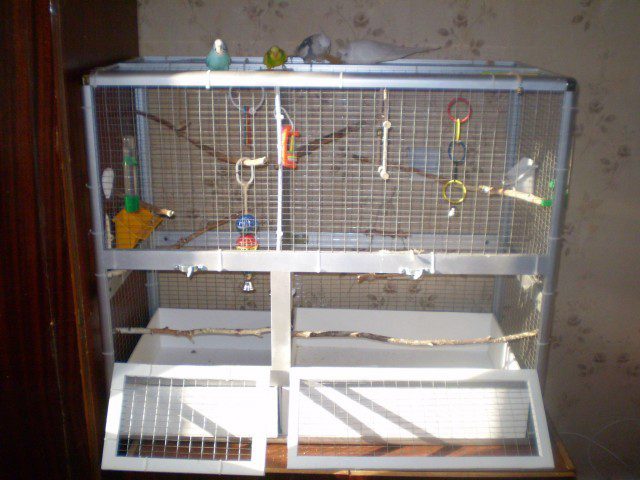
Welded mesh is very convenient to attach to any surface, and it is practical to use.
After you have decided on the place where the aviary will be located and what kind of lighting will be (if without access to sunlight, then select an artificial light source suitable for the parrot), you need to calculate the number of doors, since in addition to what you may have to attach to one of them nesting house or bathing room, you will need a door for changing food and water, as well as for cleaning the room and catching birds.
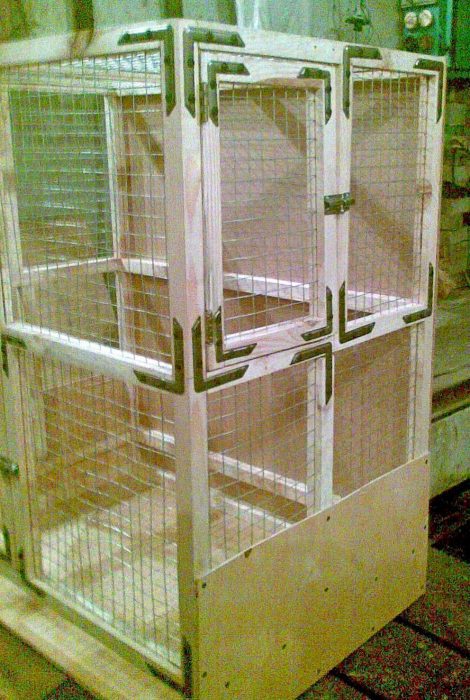
The floor in such enclosures contains pallets, so it is much more convenient to clean the cage. If you decide to buy food-grade plastic kitchen trays, then the size of the enclosure will have to be adjusted to fit them, in other cases this does not need to be done. Do not forget that since the pallet extends completely, it is necessary to have a place for such manipulations.
If you have a low pallet, make high sides to avoid debris around the enclosure. Heavy and large pallets are equipped with wheels. The bottom of the enclosure is made of plywood.
An example of building a small aviary for small and medium parrot species is here.
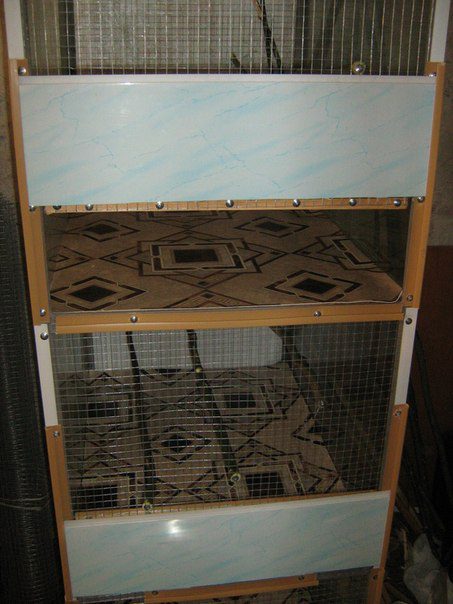
When building an aviary for large parrots, as well as medium ones, often the owners in the pallet use granular wood cat litter. For birds, it is of no interest, but it perfectly retains dust, particles of food and absorbs the consequences of bathing.
An example of an indoor aviary for a large parrot (link under the photo):

Aviaries for parrots, both indoor and outdoor, are equipped based on the preferences of the owner and the type of parrot. Knowing the nature of the bird and its sympathy for certain accessories, you can hang a bell, a rope ladder or your favorite bird swing in a large outdoor aviary. If you have a flock of wavy ones, then the best way out would be a long home-made ladder made of acceptable wood species – the birds will be able not only to climb, but also to ride.
Parrot enclosures are a great way to give your parrot some freedom, let it enjoy fresh air, sunshine and even short-term outdoor flights. By cleverly designing this huge cage, your bird will be safe, and you will be able to safely watch your happy pet.
Video with parrots living in aviaries:
https://www.youtube.com/watch?v=aQFLV4QSefY https://www.youtube.com/watch?v=8rAt0lXlwF0 https://www.youtube.com/watch?v=FUFi7c6HYcg
Ideas for building an aviary with your own hands:
https://www.youtube.com/watch?v=p1P9YNmY9VU https://www.youtube.com/watch?v=dZ1ceHyP51Y https://www.youtube.com/watch?v=qdfeg-cBdCg



